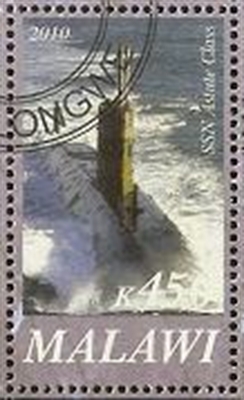|
British Royal Navy Astute class, the next generation
 The Astute class submarines are the next-generation nuclear fleet submarines of the Royal Navy. When completed, the boats will set a new standard for the Royal Navy in terms of weapons load, communication facilities, stealth and crew comfort. The boats are being constructed by BAE Systems Submarine Solutions at Barrow-in-Furness (ex VSEL). The Astute class submarines are the next-generation nuclear fleet submarines of the Royal Navy. When completed, the boats will set a new standard for the Royal Navy in terms of weapons load, communication facilities, stealth and crew comfort. The boats are being constructed by BAE Systems Submarine Solutions at Barrow-in-Furness (ex VSEL).
The Royal Navy has changed its submarine-employment strategy from the Cold War emphasis on anti-submarine warfare to the concept of "Maritime Contributions to Joint Operations."
Original plans were for seven boats of the Astute class to replace five Swiftsure class submarines (Sovereign, Superb, Sceptre, Spartan, and Splendid) and the two oldest Trafalgar class boats (Trafalgar and Turbulent). The Swiftsure class entered service between 1973 and 1977 and will be entirely decommissioned by 2010, when only the first of the Astute class will be coming into service. HMS Trafalgar was decommissioned in December 2009, to be followed by HMS Turbulent in 2011.
Approval for studies to define the "Batch 2 Trafalgar Class" (what would become the Astute class) was given in June 1991. In July 1994 risk reduction studies were authorized in parallel with the formal bid phase of the project.
On March 17, 1997, The Ministry of Defence announced that it would place a £2 billion order for three submarines and further that they would be called the Astute class. On March 26, 1997, the contract was signed with GEC-Marconi Limited for the first three boats: Astute, Ambush and Artful. GEC would build the submarines at its VSEL subsidiary now BAE Systems Submarine Solutions.
Construction and delays
BAE Systems issued a profit warning on 11 December 2002 as a result of the cost overruns and delays it was experiencing with the Astute class and also the Nimrod MRA4 maritime reconnaissance/attack aircraft. The delay was caused primarily by the problems of using 3D CAD; Armed Forces Minister Adam Ingram said in 2006 that "Due to the complexity of the programme, the benefits that CAD was envisaged to provide were more difficult to realise than either MOD or the contractor had assumed." Other issues were the insufficient capabilities within GEC-Marconi which became evident after contract-award and poor programme management. BAE and the Ministry of Defence reached an agreement in February 2003 whereby they would invest £250 million and £430 million respectively to address the programme`s difficulties.
A major element of this was the enlisting of advice and expertise from General Dynamics Electric Boat. The MOD also signed a design and production drawing work contract through the U.S. Navy which ran from 2004 to 2007.
Work on the second and third submarines, Ambush and Artful, proceeded well with major milestones such as the closure of Ambush`s reactor compartment, demonstrating significant schedule advance compared with Astute. BAE Systems and the MOD have made efforts to reduce costs and achieved significant cost-cutting and productivity gains. A £580 million cost increase was agreed in 2007 due to maturing of the design requiring more materials, inflationary costs, and "some programme throughput assumptions at the Barrow site not being borne out." First-of-class HMS Astute was launched on 8 June 2007. As of December 2008 the programme was 48% (or £1.2 billion) over-budget and 47 months late!
Specifications, Astute class:
All boats are being built by GEC at its VSEL subsidiary now BAE Systems Submarine Solutions.
Astute class boats are powered by a Rolls-Royce PWR2 (Core H) reactor and fitted with a pump-jet propulsor. The PWR2 reactor was developed for Vanguard class ballistic missile submarines. As a result Astute class boats are about 30 per cent larger than previous British attack submarines, which were powered by smaller reactors.
Like all Royal Navy submarines, the bridge fin of the Astute class boats is specially reinforced to allow surfacing through ice caps. They can fire Tomahawk cruise missiles from their launch tubes, including the new "tactical Tomahawk" currently under development. More than 39,000 acoustic tiles mask the vessel`s sonar signature, giving the Astute class a better stealth quality than any other submarine previously operated by the Royal Navy.
Displacement (srf/sub tons): 6,500/7,200
Dimensions (L*B*D feet/meter): 323’0*37’0*33’0/97.0*11.3*10.0
Propulsion: Rolls-Royce Pressurized Water Reactor PWR-2 23,500hp, 2*Alsthom geared steam turbine, 1*Rolls Royce pump-jet propulsor, 2*MTU 600KW diesel generator, one screw
Speed (sub knots): 29
Range (srf/sub miles@knots): not relevant
Diving depth (feet/meter): 1000/300
Complement: 12 officers 86 enlisted
Missile: SSM sub-launched anti-ship missile; McDonnell Douglas UGM 84 Sub Harpoon, and Hughes Tomahawk Block IV, SLCM sub-launched cruise missiles
Torpedo: 6*21" (533 mm) bow torpedo tubes, can fire Spearfish and Tigerfish torpedoes, total of 38 torpedoes or missiles reloads.
Armament: none
Mines: two Stonefish or Sea Urchin can be carried in place of one torpedo
Construction.
Currently, 2010, 3 boats are under construction; HMS Astute S-119, laid down January 2001, launched June 2007. HMS Ambush S-120, laid down October 2003. HMS Artful S-121, laid down March 2005.
Back to History Index
 |
Malawi |
2010 |
SSN Astute class (British Navy Fast Attack Submarine, SSN, HMS Astute S-119, 2010) |
|